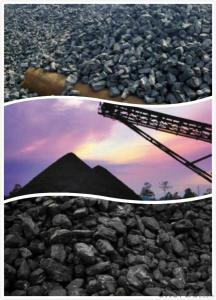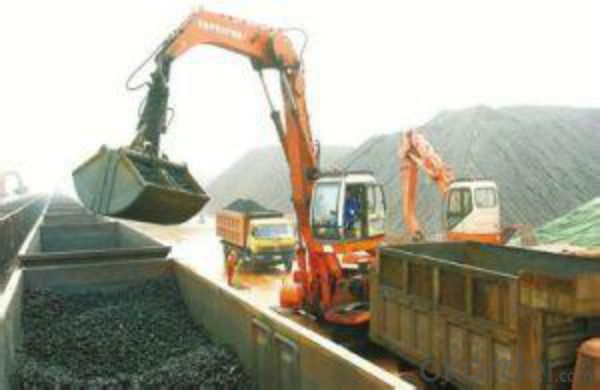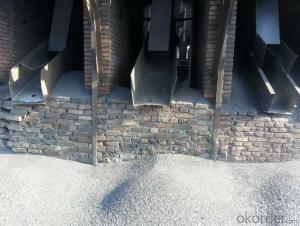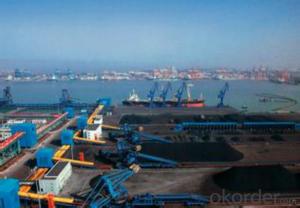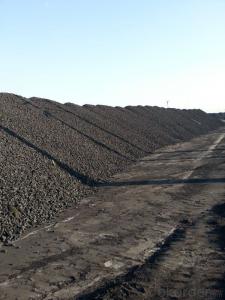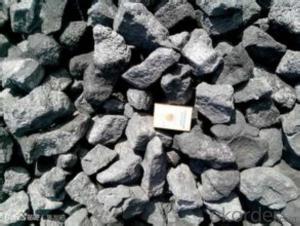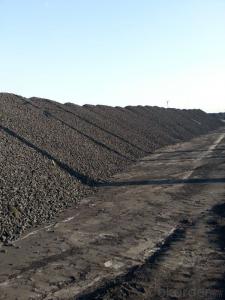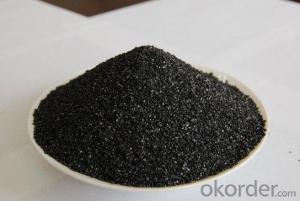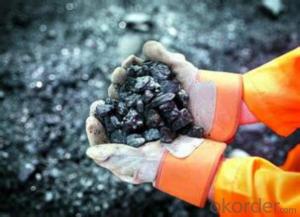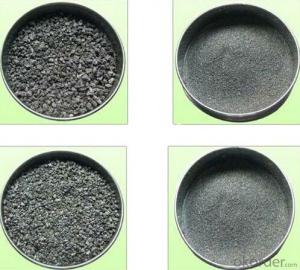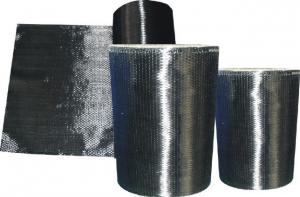Ash 13%Max Met Coke 10- 25mm Made in China
- Loading Port:
- Tianjin
- Payment Terms:
- TT OR LC
- Min Order Qty:
- 900 m.t.
- Supply Capability:
- 15000 m.t./month
OKorder Service Pledge
OKorder Financial Service
You Might Also Like
Product Description
Met Coke(metallurgical coke) is a carbon material resulting from the manufactured purification of multifarious blends of bituminous coal. its medium-grade composite contains a high occurrence of unstable components.
Features
It is widely used in casting and metallurgy Smelting every tons Irons need about 0.4 to 0.6ton coke. As the reducing agent in the steel-making and foundry industry. It is playing more and more important role in the steel industry.
Specification
Item No. | Ash (%) max | S (%) max | F.C. (%) min | V.M (%) max | Moisture (%) max | P (%) max | CSR (%) min | CRI (%) max | Cal.Value (≥Kcal/Kg) |
NF-M001 | 9 | 0.6 | 89.5 | 1.2 | 5 | 0.035 | 65 | 25 | 7250 |
NF-M002 | 10.5 | 0.6 | 88 | 1.2 | 5 | 0.035 | 65 | 25 | 7100 |
NF-M003 | 12 | 0.6 | 86.5 | 1.5 | 5 | 0.035 | 63 | 28 | 6900 |
NF-M004 | 13 | 0.6 | 85.5 | 1.5 | 5 | 0.035 | 60 | 30 | 6800 |
Pictures
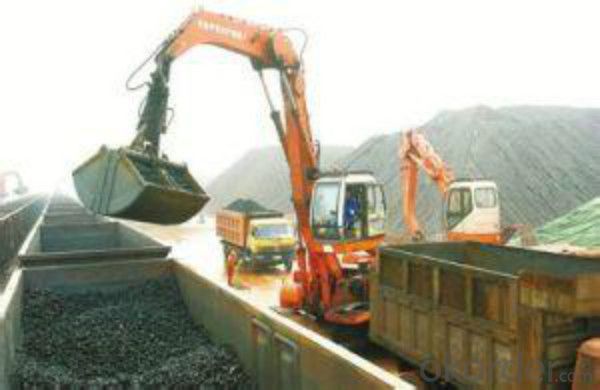
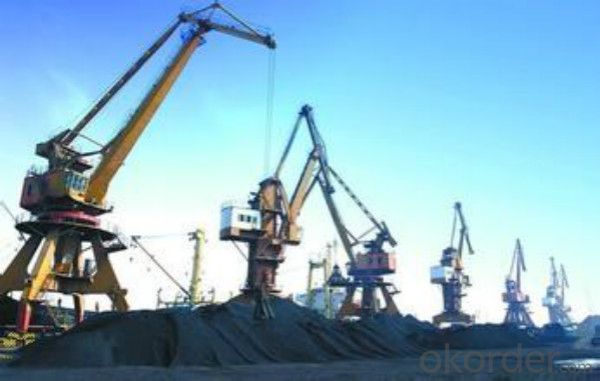
FAQ
1 What is the packing?
Packaging Details: | 1. jumbo ton bag |
Delivery time? Delivery Detail: |
15 days after we get the advanced payment or original L/C |
2 Payment terms?
D/P, L/C,T/T with advanced payment
- Q: What is the role of carbon in the formation of diamonds?
- The role of carbon in the formation of diamonds is crucial as it is the sole element responsible for the creation of these precious gemstones. Diamonds are formed deep within the Earth's mantle, under extreme pressure and temperature conditions. Carbon atoms, when subjected to immense pressure and heat, undergo a process called graphitization, where they rearrange their atomic structure and transform into a crystal lattice arrangement, giving rise to the formation of diamonds. The process starts with carbon-rich materials, such as organic matter or carbon-bearing minerals, being exposed to the intense heat and pressure found deep within the Earth's mantle, typically at depths of around 150 to 200 kilometers. Under these conditions, the carbon atoms within these materials are forced to bond together in a unique way, forming the rigid, three-dimensional lattice structure characteristic of diamonds. The formation of diamonds requires specific geological conditions, including temperatures above 900 degrees Celsius and pressures exceeding 725,000 pounds per square inch (50,000 atmospheres). These extreme conditions are typically found in areas where ancient tectonic plates collide or in volcanic eruptions that bring diamonds to the Earth's surface. Carbon's ability to form strong covalent bonds with other carbon atoms is what allows the transformation into diamonds. Each carbon atom forms four strong covalent bonds, creating a tetrahedral structure. This strong bonding allows diamonds to possess exceptional hardness, making them one of the hardest substances known to man. In summary, carbon plays an essential role in the formation of diamonds, undergoing graphitization under immense pressure and temperature conditions to create the unique crystal lattice structure that gives diamonds their extraordinary properties. Without carbon, the formation of diamonds as we know them would not be possible.
- Q: What is carbon neutral certification?
- Carbon neutral certification is a recognition given to individuals, organizations, or products that have successfully reduced their carbon footprint to zero by balancing their greenhouse gas emissions with an equivalent amount of carbon offsets or renewable energy. It signifies a commitment to mitigating the negative environmental impact and contributing to a more sustainable future.
- Q: What is carbon Yi virus?
- The best time for colony characterization was 12~15 hours. Colonies are sticky, inoculated with needle hook can be drawn into wire, called "drawing" phenomenon. In the ordinary broth for 18~24 hours, the bottom of the pipe has flocculent precipitation, the growth of sterile membrane, liquid clear. The toxic strains were formed on the sodium bicarbonate plates and cultured in 20%CO2, and the mucoid colonies (capsules) were rough, while the avirulent ones were rough. (three) resistance, propagule resistance is not strong, easy to be killed by general disinfectant, and spore resistance, in a dry room temperature environment can survive for decades, in the fur can survive for several years. Once the pasture is contaminated, the spore can survive for years to decades. Boil 10 minutes or dry hot 140 hours 3 hours, can kill spore. Anthrax spore is particularly sensitive to iodine and is highly sensitive to penicillin, cephalosporin, streptomycin, kanamycin and so on.
- Q: What are the consequences of increased carbon emissions on coral reefs?
- The consequences of increased carbon emissions on coral reefs are highly detrimental. Elevated carbon dioxide levels in the atmosphere lead to ocean acidification, which negatively impacts the ability of corals to build their calcium carbonate skeletons. This results in weakened and brittle coral structures, making them more susceptible to damage from storms and other environmental stressors. Additionally, higher temperatures caused by carbon emissions contribute to coral bleaching events, where corals expel the symbiotic algae that provide them with essential nutrients and vibrant colors. These combined effects of ocean acidification and warming ultimately lead to significant coral reef degradation, loss of biodiversity, and the decline of ecosystem services provided by these valuable marine habitats.
- Q: What are the consequences of increased carbon emissions on public health systems?
- Increased carbon emissions have significant consequences on public health systems. One of the most prominent effects is the exacerbation of respiratory diseases such as asthma, chronic obstructive pulmonary disease (COPD), and bronchitis. Carbon emissions contribute to the production of fine particulate matter (PM2.5) and ground-level ozone, both of which can penetrate deep into the respiratory system and cause or worsen these conditions. Moreover, higher levels of carbon emissions are correlated with an increased prevalence of cardiovascular diseases. Fine particulate matter and other pollutants released from carbon-emitting sources can enter the bloodstream, leading to inflammation, oxidative stress, and the development of atherosclerosis. Over time, this can result in heart attacks, strokes, and other cardiovascular complications. Climate change, driven by carbon emissions, also impacts the spread of infectious diseases. Rising temperatures and altered precipitation patterns create favorable conditions for the expansion of disease vectors like mosquitoes and ticks, leading to the transmission of diseases such as malaria, dengue fever, Lyme disease, and Zika virus. Additionally, extreme weather events and natural disasters associated with climate change can disrupt healthcare infrastructure and compromise access to essential services, further impacting public health systems. Furthermore, mental health is also affected by increased carbon emissions. The environmental degradation caused by carbon emissions contributes to feelings of anxiety, stress, and depression, often referred to as eco-anxiety or climate grief. The loss of biodiversity, destruction of natural habitats, and the overall uncertainty surrounding the future can have detrimental effects on individuals and communities, requiring additional resources and support from public health systems. In summary, increased carbon emissions have far-reaching consequences on public health systems. They contribute to the prevalence of respiratory and cardiovascular diseases, facilitate the spread of infectious diseases, and impact mental health. Addressing carbon emissions and implementing sustainable practices are essential to mitigating these consequences and safeguarding the well-being of individuals and communities.
- Q: What are the effects of carbon emissions on the stability of wetlands?
- Carbon emissions have significant effects on the stability of wetlands. One of the main consequences is the alteration of the hydrological cycle, which can disrupt the delicate balance of water levels in wetland ecosystems. Increased carbon emissions contribute to climate change and global warming, leading to higher temperatures and altered precipitation patterns. These changes can result in more frequent and intense droughts, floods, and storms, which can negatively impact the stability of wetlands. Elevated carbon dioxide levels also affect the vegetation in wetlands. Excess carbon dioxide can stimulate the growth of certain plant species, leading to an imbalance in the wetland ecosystem. This can result in the dominance of invasive species, which outcompete native plants and disrupt the natural biodiversity of the wetland. In turn, this can impact the stability of the wetland as it relies on a diverse range of plant species to support the intricate web of life within it. Furthermore, carbon emissions contribute to the acidification of water bodies, including wetlands. Increased carbon dioxide dissolves in water, forming carbonic acid, which lowers the pH of the water. Acidic conditions can be detrimental to the survival of many wetland species, including plants, amphibians, fish, and invertebrates. The acidification of water can also lead to the leaching of toxic metals and other pollutants from surrounding soils, further compromising the stability and health of wetland ecosystems. Lastly, carbon emissions contribute to the rise of sea levels due to the melting of polar ice caps and thermal expansion of ocean waters. This poses a significant threat to coastal wetlands, which are particularly vulnerable to sea-level rise. As sea levels increase, saltwater intrusion can occur, leading to the degradation and loss of freshwater wetlands. This can result in the displacement or extinction of numerous plant and animal species that rely on these ecosystems, ultimately destabilizing the wetland. In conclusion, carbon emissions have profound effects on the stability of wetlands. From altering the hydrological cycle and vegetation composition to causing acidification and sea-level rise, these emissions pose a significant threat to the health and integrity of wetland ecosystems. It is crucial to mitigate carbon emissions and take measures to protect and restore wetlands to ensure their stability and preserve the invaluable services they provide.
- Q: How does carbon affect air quality?
- Air quality can be affected both positively and negatively by carbon. On the one hand, carbon dioxide (CO2) is a natural part of the Earth's atmosphere and vital for plant survival and photosynthesis. Nevertheless, an excess of CO2 can contribute to the greenhouse effect, resulting in global warming and climate change. Furthermore, carbon monoxide (CO), a harmful pollutant produced during incomplete combustion, can have a detrimental impact on air quality. It is primarily released by vehicles, industrial processes, and residential heating systems. Elevated levels of carbon monoxide can impede the body's oxygen delivery, causing various health problems such as headaches, dizziness, and in severe cases, even death. Additionally, compounds containing carbon, like volatile organic compounds (VOCs), can play a role in the creation of ground-level ozone, which is a harmful pollutant. Ground-level ozone can lead to respiratory issues, worsen existing respiratory conditions, and reduce lung function. VOCs are emitted by different sources, including vehicle emissions, industrial processes, and specific household products. In conclusion, while carbon dioxide is crucial for life on Earth, excessive amounts can contribute to climate change. Conversely, carbon monoxide and volatile organic compounds released by human activities can have adverse effects on air quality and human health. Therefore, it is crucial to decrease carbon emissions and adopt cleaner technologies to mitigate the negative impacts of carbon on air quality.
- Q: What is carbon dioxide?
- Carbon dioxide (CO2) is a colorless and odorless gas that consists of carbon and oxygen atoms. It is formed through the combustion of fossil fuels, as well as the natural processes of respiration and volcanic activity. Carbon dioxide plays a crucial role in the Earth's atmosphere as a greenhouse gas, trapping heat and contributing to the planet's overall temperature. While it occurs naturally, human activities such as burning of fossil fuels and deforestation have significantly increased its concentration in the atmosphere, leading to global warming and climate change. Carbon dioxide is also a byproduct of various industrial processes, such as cement production and power generation. Efforts to reduce carbon dioxide emissions are essential to mitigate the effects of climate change and maintain a sustainable environment.
- Q: How can carbon capture and storage help reduce greenhouse gas emissions?
- CCS has the potential to make a significant contribution in the fight against greenhouse gas emissions. Its core process involves capturing carbon dioxide emitted from industrial activities or power generation, transporting it, and then underground storage in geological formations. To begin with, CCS can effectively reduce greenhouse gas emissions by capturing CO2 directly from major sources like power plants and industrial facilities. Without CCS, these sources would release CO2 into the atmosphere, exacerbating the greenhouse effect and further contributing to climate change. By capturing and storing this CO2, the negative impact on climate change is mitigated. Additionally, CCS allows for the continued use of fossil fuels, such as coal or natural gas, in a more environmentally friendly manner. These fuels are currently the main sources of energy for electricity generation and industrial processes. By implementing CCS, the emissions of CO2 from these fossil fuel activities can be significantly reduced, facilitating a gradual and economically feasible transition to cleaner energy sources. Moreover, the combination of CCS with bioenergy production creates a process known as BECCS. This involves using biomass, like crop residues or energy crops, to produce energy. The CO2 emitted during this bioenergy production is captured and stored, resulting in a net-negative emissions process. BECCS effectively removes CO2 from the atmosphere, offsetting emissions from other sectors. Lastly, CCS can play a crucial role in the decarbonization of hard-to-abate sectors, such as cement and steel production, where low-carbon alternatives are currently limited. By capturing and storing CO2 emissions from these sectors, CCS significantly reduces their overall greenhouse gas emissions and supports their transition towards more sustainable practices. In conclusion, the implementation of carbon capture and storage technology is essential in reducing greenhouse gas emissions. It directly captures and stores CO2 from major sources, allows for the sustainable use of fossil fuels, enables negative emissions through BECCS, and aids the decarbonization of challenging sectors. By incorporating CCS alongside other mitigation strategies, global climate goals can be achieved, and the battle against climate change can be fought effectively.
- Q: What is the structure of graphite, another form of carbon?
- Graphite is a unique form of carbon that exhibits a distinct structure, different from other forms such as diamond or amorphous carbon. Its structure consists of layers of carbon atoms arranged in a hexagonal lattice. Each carbon atom forms covalent bonds with three neighboring carbon atoms, resulting in a two-dimensional sheet-like structure. Within each layer, the carbon atoms are bonded together through strong covalent bonds, forming a planar network. The carbon-carbon bonds in graphite are significantly stronger than typical single bonds, making the structure highly stable. The hexagonal lattice arrangement of carbon atoms creates a honeycomb-like pattern, giving graphite its characteristic appearance. The layers in graphite are held together by weak van der Waals forces, allowing them to slide past each other with ease. This property gives graphite its lubricating nature, as well as its ability to leave a mark on paper when used as a pencil lead. The arrangement of carbon atoms in graphite also leads to its excellent electrical conductivity. The delocalized electrons in the structure can move freely along the layers, allowing for the flow of electric current. This property makes graphite useful in various applications, including electrical components, electrodes, and as a lubricant in high-temperature environments. In summary, the structure of graphite consists of layers of carbon atoms arranged in a hexagonal lattice, bonded together by strong covalent bonds within each layer and held together by weak van der Waals forces between the layers. This unique structure gives graphite its distinct properties, such as its lubricating nature, electrical conductivity, and versatility in various industrial applications.
Send your message to us
Ash 13%Max Met Coke 10- 25mm Made in China
- Loading Port:
- Tianjin
- Payment Terms:
- TT OR LC
- Min Order Qty:
- 900 m.t.
- Supply Capability:
- 15000 m.t./month
OKorder Service Pledge
OKorder Financial Service
Similar products
Hot products
Hot Searches
Related keywords

